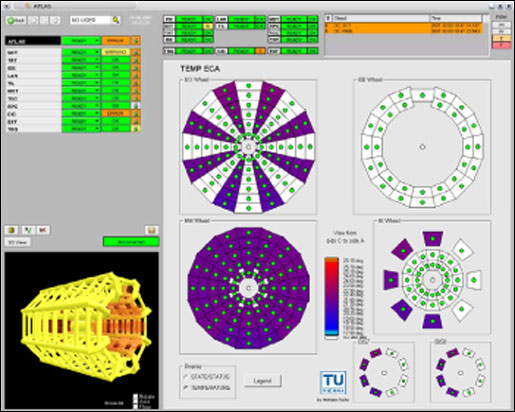
ATLAS e-News
23 February 2011
Babysitting ATLAS
18 February 2008

ATLAS DCS operator interfaceshowing the temperature of the MDT chambers in the big muon wheels of the end cap of side A.
As ATLAS is one of the most complex machines ever built, it is not as easily switched on as for example a coffee machine. Even after the huge detector has been brought into an operational state, its health must be monitored continuously and the slightest sneeze must be dealt with as soon as possible. A complex network of sensors, cables, and electronic boards together with more than 150 computers – the Detector Control System (DCS) – feel the heartbeat of the detector and propagate commands given from the ATLAS control room to the detector elements.
About hundred DCS experts from various institutes within the collaboration are working together to make ATLAS easily controllable from the desks of the control room on the surface. A major milestone was achieved last October where most of the detector was supervised for one week of combined cosmic ray data taking exclusively by shift personnel in the main control room. Using the DCS, it was possible to power complete sub-detectors of ATLAS with a single mouse-click. During running, any occurring problem of the detector hardware which could disturb the successful data taking was signaled, investigated and solved with the help of the various detector experts. Currently, the next combined data taking milestone in the beginning of March is prepared, where for the first time all ATLAS sub-detectors will run round-the-clock for a few days, watched continuously by a DCS shifter.
Of major importance for the ongoing commissioning of ATLAS is the Common Infrastructure Control (CIC). The environment of the detector cavern and all electronics rooms, such as air and cooling water temperature, humidity and pressure, is monitored and any abnormal condition is reported to the control room and sent via SMS to the counting room management in charge. All electronic racks in the counting rooms are monitored and can be switched from the main DCS operator console which has proven its usefulness especially during the frequently occurring shutdown and maintenance periods. Even the movement of people working within the detector itself is tracked by a network of more than 500 infrared sensors as part of the Finding Persons Inside Atlas Area (FPIAA) system.
New detector systems are integrated into the ATLAS DCS every week as ATLAS is nearing completion. The most recent addition was the temperature monitoring of the MDT chambers, which provides together with the Inner Detector environment monitor a precise temperature map of the complete ATLAS volume. With the LHC commissioning knocking on our door, the DCS awaits to be interfaced with the accelerator controls in the near future, reporting the beam status and conditions to the ATLAS sub-detectors ensuring together with the Beam Interlock System the safety of all detector components.
The status of ATLAS can be watched worldwide 24 hours per day by using a common web browser on http://pcatdwww.cern.ch/atlas-point1/dcs/, which was heard to sometimes significantly shorten the coffee break of some experts – even if the coffee machine was working properly.

Helfried BurckhartCERN |

Stefan SchlenkerCERN
|